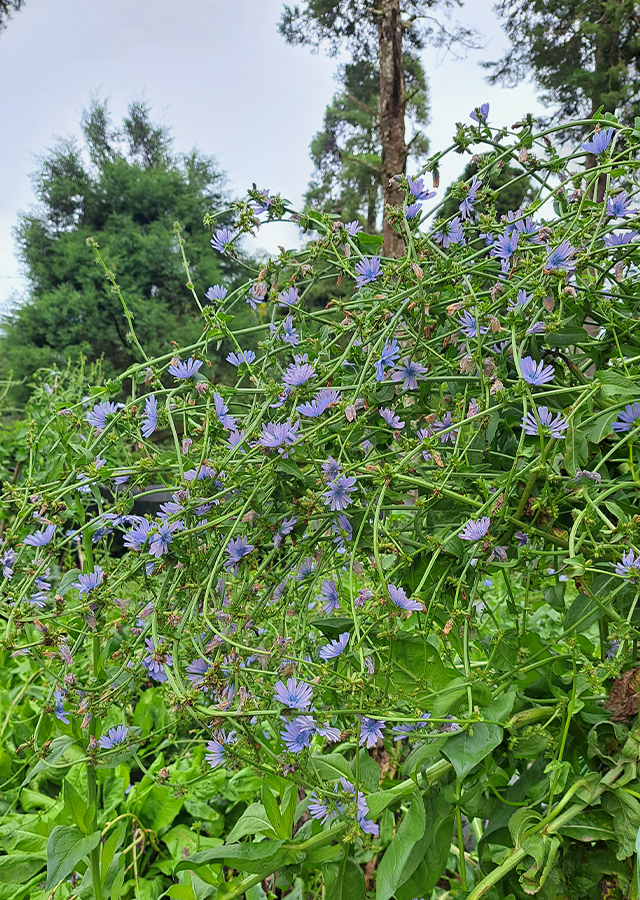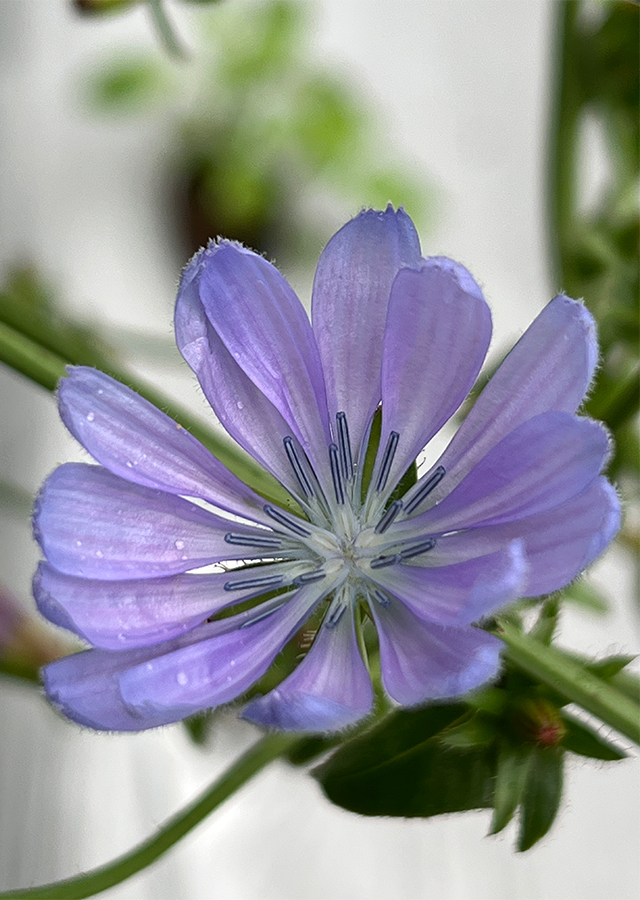Traditional Herbs from Cichorium intybus
cure_wounds
- Take fresh chicory leaves, wash them thoroughly.
- Crush them until they become a paste.
- Apply the paste to the wound
treat_tumors
- Prepare fresh chicory leaves, wash them thoroughly.", "Boil for\u00a0\u00a05-10 minutes.
- Strain then drink.
What is Cichorium intybus Looks like??



Parts of Cichorium intybus that could be used
- Leaves", "Flowers", "Roots", "All Parts of the Plant
Cichorium intybus Distribution
Chicory originates from Europe, West Asia, and Central Russia. It grows as a weed in temperate climates and is now widely distributed in North America, China, and Australia. Chicory is also an important medicinal plant in Eurasia and in parts of Africa. Cultivated chicory can be divided into four groups according to its use, namely "industrial" or "root" chicory, mainly cultivated in North-Western Europe, India, South Africa, and Chile, where the roots are used as a substitute for coffee or for the extraction of inulin; "Brussels" or "witloof" chicory is commonly cultivated throughout Europe as industrial chicory for its etiolated buds (chicons); chicory �leaves� are used as a fresh or cooked vegetable; and finally as "fodder". Historically, chicory also has a long history of use as a medicinal plant, where it has been used by people to treat various diseases ranging from wounds to diabetes. Chicory is a good source of vitamins (A, B1, B2, B3, B5, B6 and C), minerals (including zinc, magnesium, manganese, calcium, iron folic acid and potassium), and other essential nutrients, if consumed regularly and in appropriate doses. Chicory extract is sometimes added to alcoholic and non-alcoholic drinks to enhance the taste. Apart from that, chicory is also used in industrial purposes, as the best herbal diuretic, and helps in the production of biomass and is the strongest hepatoprotective agent.Agroecology of Cichorium intybus
Chicory usually grows in open land, disturbed areas, empty land, ditches, along cultivated land and roadsides, grasslands. Found growing in temperate climates. Chicory grows in all types of soil, but when cultivated, it grows best in rich, well-drained soil, peat, sandy loam, or warm, moist sand. Chicory is a hardy plant and is resistant to extreme temperatures during the vegetative and reproductive growth stages. Likes full sun and is also drought tolerant. Prefers soil with an acidity level (pH) of 5.5 to 7, but tolerates a pH in the range of 4.5 to 8.3.
Morphology of Cichorium intybus
- Single root, long, thick, strong, fleshy taproot and spindle-shaped like a carrot." which are stiff and spreading. The lower part of the stem is hairy.
- Rosette leaves at the base of the plant or above the long, fleshy taproot, oval or oval-spatulate (ovate). inverted/supula), green, stemmed, coarse hairs on the upper and lower surfaces. The edges of the leaves are shallow or very deeply toothed. Have a slightly bitter taste.
- Flowers are usually bright blue, rarely white or pink, have legs long, strap-shaped with 5 apical teeth. There are two rows of involucral bracts, namely the inner one is longer erect and the outer one is shorter and spread out. Each flower only lasts one day, blooms in the morning and closes in the afternoon flower heads, with 12-30 flowers each. 0.3 cm, dark brown and wedge-shaped. Fruits (achenes) have no petals or are hairy and have toothed scales on the apex. The fruit consists of one seed.
- Obovate seeds that are light brown in color.
Cultivation of Cichorium intybus
- Plant propagation through seeds.
- Sow in place or in pots, then plant as soon as they are large enough.
Cichorium intybus, more details :
Chemical Content of Cichorium intybusChicoric acid, amino acids (tryptophan, threonine, isoleucine, leucine, and lysine), inulin, coumarin, tannins, flavonoids (anthocyanins, flavonols, flavanones, and flavan-3-ols), sesquiterpene lactones (lactucin and lactucopyrin), alkaloids , saponins, aliphatic compounds, saccharides, methoxycoumarin cichorine, essential oils, volatile compounds (octane, n-nonadecane, pentadecanone), cichoriin (esculetin-7-glucoside).
Benefits of Cichorium intybus
Treats jaundice, uterine cancer and tumors, helps heal wounds, bruises, internal bleeding, liver disorders (enlarged liver), hemorrhoids, diabetes, reduces joint pain or arthritis, eliminates symptoms associated with mild digestive disorders (bloating and slow digestion), constipation, diarrhea, tonic and stimulant to increase appetite, treat gallstones, kidney disorders, gastroenteritis, sinus problems, increase the amount of urination, reduce levels of "bad" cholesterol in the body, lower high blood pressure, prevent cardiovascular disease, soothe and reduces anxiety or relieves stress, relieves coughs, helps lose weight, treats swollen and inflamed eyes. Has activity as an antioxidant, antimalarial, anti-inflammatory, anticancer, antiparasitic, antihepatotoxic.
Simplisia of Cichorium intybus
- Prepare the chicory roots\u00a0then wash them thoroughly then drain them.
- Dry them in direct sunlight for several days or in an oven at a temperature\u00a040 \u00b0C until the water content\u00a010%.
- Clean them using a blender until they become powder.
- Store\u00a0simply in plastic or a clean, airtight container.
Another Facts for Cichorium intybus :
Synonym of Cichorium intybusCichorium endivia var. sativum DC., Cichorium intybus var. balearicum (Porta) Gand., Cichorium intybus var. sylvestre (Garsault) Vis.
Habitus of Cichorium intybus
Herb. Annual herb, about 1.5 m high
Habitat of Cichorium intybus
- Grassland
- Land
No comments:
Post a Comment